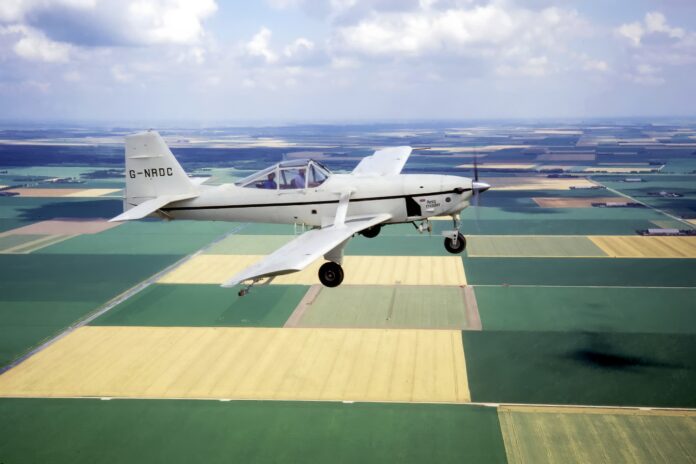By Ryan Varjassy
The NDN-6 Fieldmaster was the brainchild of British aviation legend Nigel Desmond Norman, starting in the mid-1970s. Desmond and his college friend and business partner, John Britten, formed a relationship in the 1950s at the De Havilland Technical School, where they studied aircraft design. In 1954, the two built their first aircraft called the BN1F, a 36hp ultralight.
The aircraft failed from a sales perspective but supplied them with a third partner, Jim McMahon. Together, they formed Crop Culture Aerial, which became highly successful, and along with this new partnership came the early stages of the rotary atomizer spray nozzle. Britten-Norman was formed as a company that specialized in ag operators and supplied ag conversions of Tiger Moths for export to New Zealand. They had taken over the development and sales of spraying equipment, most notably the Micronair Rotary Atomizer. At one point, John and Desmond operated a fleet of approximately 80 aircraft, and the need to consider a replacement ag plane resulted in a partnership with Leland Snow from Texas.
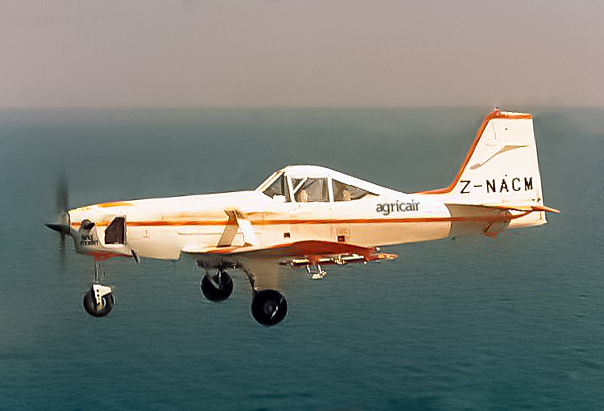
Britten-Norman acquired a 1/3 share of Snow Aeronautical Corp., and when the company was sold to Rockwell, it provided Britten-Norman with the funds to chase their dreams of designing and building their aircraft. Their idea was to build a small island-hopping passenger plane. So, after selling off their shares of Crop Culture to the other Board members in 1963, their efforts were put forth into developing the Britten-Norman Islander, which made its maiden flight in June of 1965 after only nine months of development. The factory was based at Bembridge on the Isle of Wight (IOW) off the south coast of the UK, and the small island would remain the home of Desmond’s aviation career for years to come.
Over the years, Desmond was involved with numerous other businesses and projects, but in 1971, Britten-Norman went into liquidation and was purchased by Fairey Aviation in 1972. Desmond would remain the managing director until 1976, when he formed his own aviation company, NDN Aircraft Ltd.

The next few years would see the development of three aircraft:
(1) NDN Firecracker/Turbo Firecracker – A two-place military trainer
(2) NDN-6 Fieldmaster – Agricultural / Firefighting aircraft
(3) NAC-1 Freelance – A folding wing four-place civil aircraft
The NDN-6 Fieldmaster took Desmond back to his ag aviation roots, and his aircraft design was indeed years ahead of its time. He wanted a modern ag aircraft that pushed the boundaries of what was already being manufactured…and pushed the limits he did. The aircraft included the following innovations:
– designed from the beginning to have a Pratt & Whitney PT6A-34 750 HP turboprop and could be easily upgraded to the larger PT6A-65 1250 HP engine if desired
– integral titanium 625-gallon hopper as part of the structural airframe
– aerofoil ailerons and flaps with spray booms built into the internal structure – tricycle landing gear to aid in ground visibility and the training of new pilots on the type, as most pilots are trained on a tricycle configuration
– standard dual cockpit with optional controls for training
– glass canopy for excellent visibility
Options included the following:
– firebombing drop gate
– 40 or 80 nozzle option
– Transland spreader
– Micronair Rotary Nozzles (8), Micronair Flow-meter and RPM indicator
– Automatic Flagman
– lighting packages for navigation, instruments, strobe, beacon, and retractable working lights, both forward and tip mounted, for turning
– IFR instruments
– heat and air conditioning
– 2-speed windshield wiper and washer system
The Fieldmaster appeared to be a state-of-the-art ag aircraft with every possible option. Desmond performed the first flight on December 17, 1981, at Sandown Airfield in the Isle of Wight, where the aircraft was built in his small hangar factory. As the story goes, he wears his traditional pinstriped suit and sets out to put the aircraft through its paces. A short flight was initially planned, but the flight time gradually grew and grew without Desmond landing at the airfield. After approximately 30-40 minutes, he finally landed unscathed. He promptly stated that the rudder and vertical fin needed to be changed as he could not make the aircraft turn with any real authority, so he had to make a large loop to get back to the airfield.
The Fieldmaster, G-NRDC, got its registration from the project sponsor National Resource Development Corporation. She made her public debut at the Farnborough in February 1982. Again, at the Farnborough 50th Anniversary SBAC in September 1982, test flying, and upgrades continued through 1983, 1984, and 1985, leading to a new production factory being built in Cardiff, Wales, with support from the Welsh Development Agency. On July 22, 1985, NDN officially moved to Cardiff, and at the same time, the name was changed from NDN to NAC (Norman Aeroplane Co.). The factory was staffed, and preparations for production of the NAC-6 Fieldmaster were being finalized. Many notable hires were made at this time, from production line workers to electrical, airframe, and engine engineers, with one notable hire being Vic Osborne. Vic was an electrical engineer, but he would soon become the sole engineer on the Fieldmaster project within a few years. His contributions to the Fieldmaster program cannot be overstated, and his importance will become apparent in the future of the aircraft.
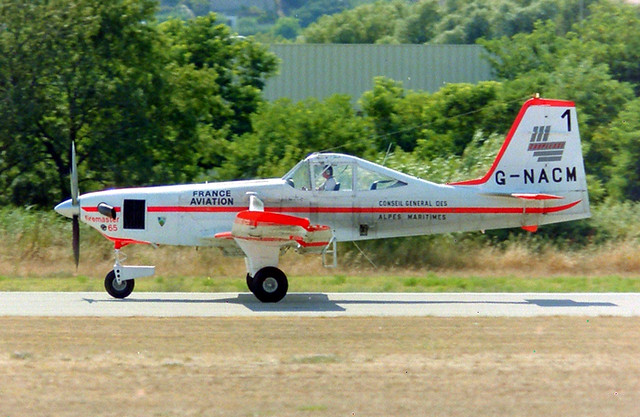
NAC continued using the original aircraft, NRDC, for testing purposes by doing crop dusting tests in Lelystad, Holland (the Netherlands) for Heyboer BV, working alongside Turboprop Thrush aircraft and Miller Aerials Turboprop Ag-Cats. They were testing and using the Micronair systems mounted to traditional drop booms instead of its internal booms, as the rotary atomizers could not be adapted to the internal boom system. They were also testing the aircraft for firefighting roles during this time. They had developed a water boom/scoop, allowing the aircraft to refill with water by skimming the water with the boom lowered at about 10 feet above it. The rear seat spotter operated the water boom using a hand crank attached to a steel cable. Vic Osborne did much of the back seat work during this testing phase and said cranking that boom up and down was an awful experience and that his arm would go numb from raising the boom. Vic also did photo and video work for the boom testing and fire drops from the NAC Freelance with Desmond at the controls. The back seater was also a lookout for watercraft and debris in the water while on the water scooping passes. The pilot planted the boom scoop firmly in the water, adjusting trim and airspeed as the hopper filled. The filling sequence would take up to 1 minute and 30 seconds as long as the boom wasn’t skipping off the water, but the pilots would only keep the boom in the water for 15 to 20 seconds at a time due to the high level of concentration needed. The system worked but was never implemented commercially, and testing ceased.
The production line at Cardiff was moving along, and in early 1987, the first production aircraft was nearing completion. G-NACL would be the first aircraft produced under the new NAC company name, and on April 28, 1987, they received the type certificate from the UK CAA (Civil Aviation Authority). On the same day, NACL performed its first flight with the prototype NRDC, flying along in formation with Desmond Norman and test pilot Peter Phillips at the controls. NACL flew in primer as Desmond wanted to save the cost of a new paint job in case of an accident.
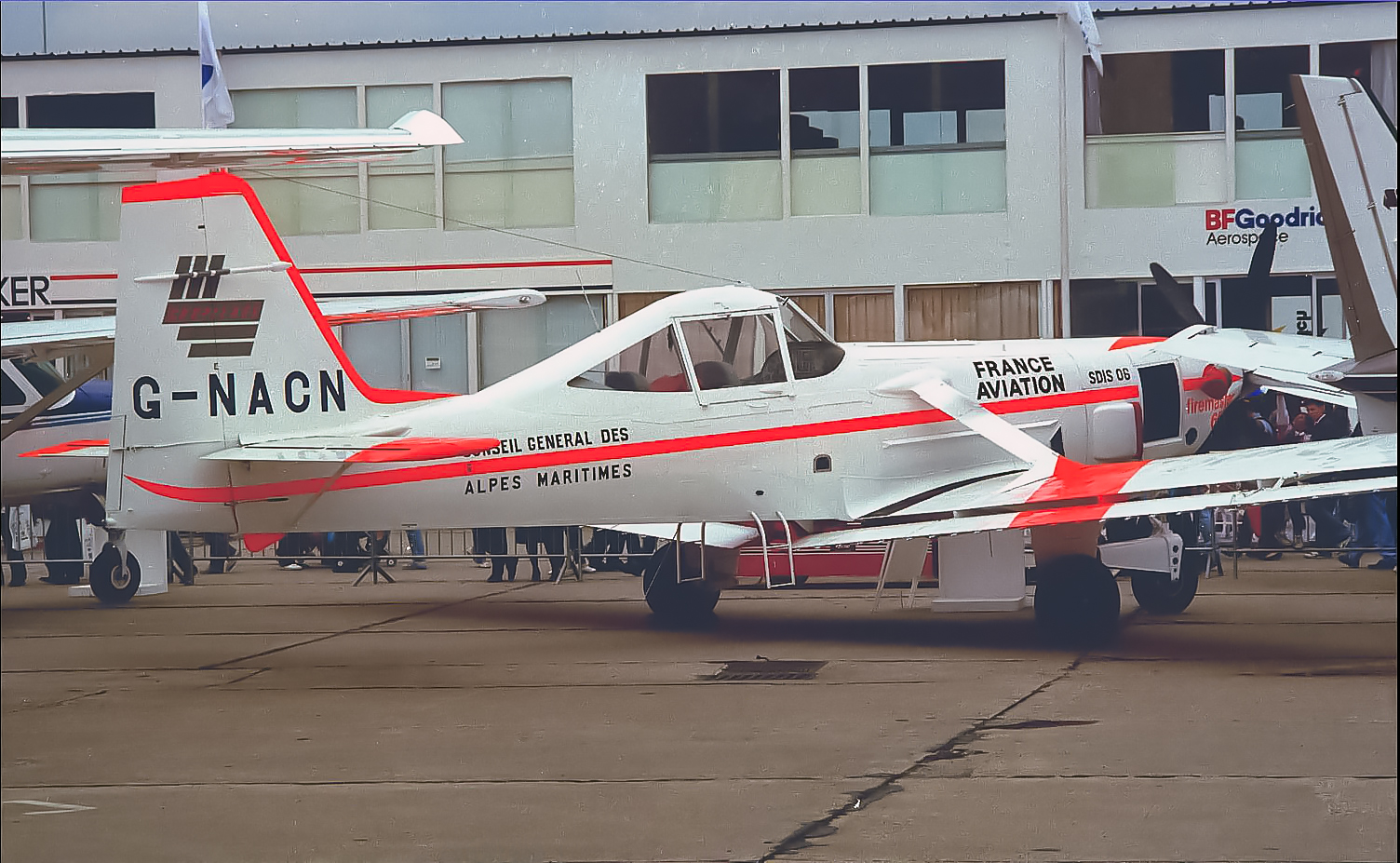
Through May and June of 1987, NACM & NACN were completed and flight certified. Desmond signed a lease firefighting contract with France Aviation Conseil General Des Alpes Maritimes in Cannes in the South of France for their summer firefighting season. All three completed production aircraft were dispatched along with maintenance staff from Cardiff, including Vic Osborne. The aircraft performed well but was underpowered during high and hot conditions with a big load onboard. The planes were also used for loaded patrols, and they shined in this role as they carried massive amounts of fuel over four internal wing tanks, giving them a loiter time of 7 to 8 hours.
By the end of 1987, aircraft sales had been non-existent, so Desmond leased them to various companies to bring in revenue and test them in real-world situations. The following contract was to Agricair in Zimbabwe, Africa. ODA funded the Tse Tse fly control contract. Agricair Zimbabwe was, at the time, the leading company in Africa when it came to Tse Tse control. Agricair was owned by Field Aviation, which was owned by Hunting Aviation (UK ). As the British funded the contract, the contract was awarded to Huntings, and all the equipment to be used was to be British, hence the use of the Fieldmasters.
Only two Fieldmasters were available then, so two Thrush aircraft were used to bring the total number of aircraft to four, which required the area to be sprayed. The Fieldmasters were put into the Zimbabwe register, as Agricair was operating the aircraft, and the aircrew and engineers were all licensed in Zimbabwe. Before the contract started, the crews spent some time in Cardiff so that the engineers could assist with fitting the spray gear, navigation systems, and lights and for the new pilots to do conversions onto the aircraft. The pilots were Rob Tasker (RIP) and Glenn Brunwin. The aircraft required some modifications for the contract with the addition of the spray gear, blind flying instruments, a tiltable instrument panel in the rear cockpit to house the TANS and spray controls, and the manufacture of leading-edge protection panels for the wings and tailplane for bird strikes.
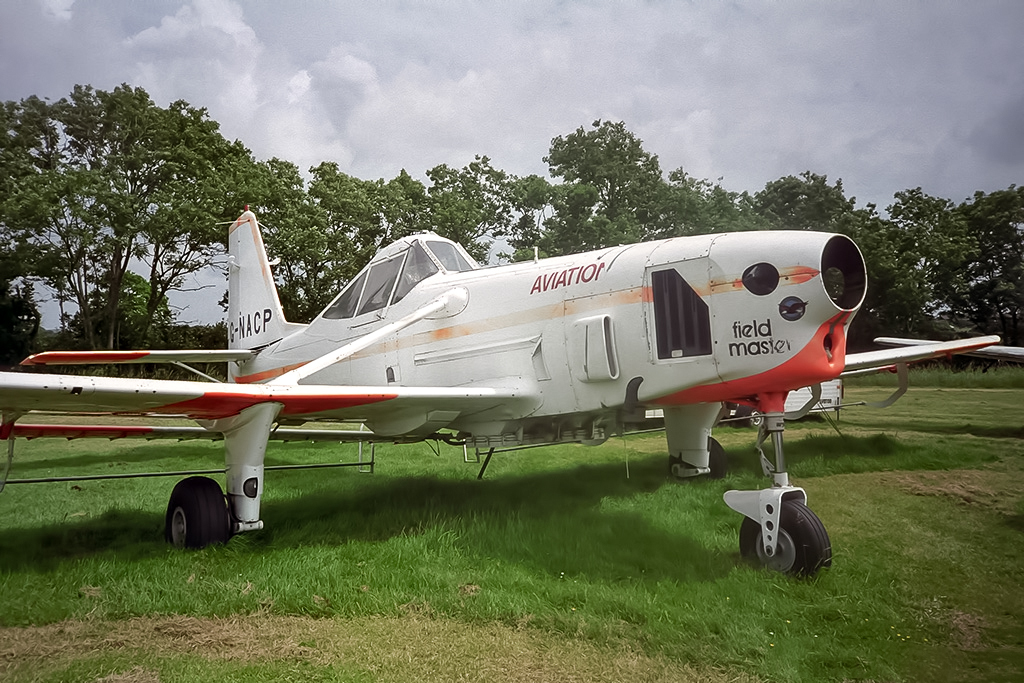
Due to bad weather, the aircraft was ferried to Somalia in December 1987 with a 3-day delay at the Air Force Base in Yeovilton, Ur. The contract was conducted in early 1988, and two aircraft formations conducted the spraying. The Fieldmasters were configured as the lead aircraft, so each formation consisted of a Fieldmaster leading, with a Thrush flying in formation. The spraying was conducted at night at 50 feet or less (tree top). The spray area was about 7000 square km and took about seven nights to complete (one cycle).
To eradicate the flies, a minimum of five cycles was required, and the scientists determined the time between each cycle, which was approximately 7 to 10 days apart. The flying crews were Rob Tasker as Pilot with Martin Ludlow as navigator in the one Fieldmaster, Hugh Mundy flying formation in a Thrush, Glenn Brunwin as Pilot, Bobby Tasker as navigator in the other Fieldmaster and Johnny Falzoi flying formation in a Thrush. John Robert McLagan Gair and others were part of the engineering team supporting the contract aircraft. Afterward, the two Fieldmasters were ferried back to Cardiff, passing over the Mediterranean Sea and the deserts of Egypt.
While NACM and NACN were working on the Tse Tse fly contract in Somalia, Desmond sent NACL on a sales tour to Australia and Singapore for the airshow in January 1988. Renowned female ferry pilot Janet Ferguson made the long trek to South Australia from Cardiff, Wales, covering 9000 miles one way. Once Janet arrived safely in Australia, NAC’s second test pilot, Doug Barden, flew on a commercial flight and took CL to various Australian states, showing off its firefighting capabilities. Australia was celebrating its bi-centennial, so the aircraft was painted with a “Happy Birthday Australia” on the aft fuselage. After touring Australia, Janet returned to the UK, stopping in Singapore to participate in the Singapore International Airshow.
By the summer of 1988, the last two production Fieldmasters were completed. NACO & NACP were flight tested and ready to join the other three production aircraft. All five of the aircraft were essentially the same…Pratt & Whitney PT6A-34 turboprops at 750 hp, 625 US gallon titanium hoppers, dual seating, and the other innovations that Desmond had designed. There were minor variations between each aircraft, but nothing major or significant. The layout worked well; all five aircraft went to France in Cannes for the 1988 firefighting season. This would be the only time all the Fieldmasters would work together in one location, minus the original prototype NRDC.

Leading up to 1988, Desmond agreed to have some Fieldmaster fuselages and wings be produced by Utva Aviation in Yugoslavia. The airframes would then be shipped back to Cardiff for final assembly. Utva found some issues with the wing root and redesigned it, providing more strength to the main spar. They also redesigned the nose section to accept a 724 shp M601D-1 Walter Turboprop as a less expensive alternative to the pricey Pratt & Whitney. This project lasted until 199,2 when war broke out in Yugoslavia, and Utva was notified that it was under Western sanctions and work on the British airframes was to cease immediately. The Utva factory suffered severe damage during the war, but miraculously, the airframes survived unscathed and were put into storage till 1999. There is more to this story, but we will continue it later.
In the early fall of 1988, NAC was under serious financial constraints due to the massive amount of money spent to get to this point of production. On July 26, 1988, NAC went into receivership with Price-Waterhouse directing the company. Desmond was out at the company that bared his name, but NAC would continue to operate until a buyer for the company could be found or the assets liquidated. As the story goes, Desmond had his Freelance aircraft and the original Fieldmaster prototype NRDC moved out of Cardiff the morning the receivers arrived to take over. For some reason, these aircraft were not to be part of the sale of the company, and Desmond made sure they were not confiscated. Some workers were laid off, while others were paid to merely show up, sweep the floors continuously, and drink coffee. But only two months later, a former financial backer of Desmond purchased NAC’s liquid assets and the rights to the Fieldmaster agricultural and firefighting aircraft, including the five production Fieldmasters.
Andrew MacKinnon and his company, Croplease Ltd., began to plan how to move forward with his new acquisition. However, Andrew was not from the aviation world but instead finance. He lived and worked in London while the aircraft was nowhere in his direct line of sight. All the employees had been let go by this time, but one engineer contacted Andrew and offered his services. At this point, Vic Osborne became the sole engineer for the Fieldmaster aircraft.
After the 1988 summer firefighting ended in France, NACL, NACM, and NACN were off to Morocco in Northern Africa to spray for a massive locust infestation. They were based in Ouarzazate, and once again, Vic was there to keep the aircraft in tip-top shape.
1989 started slowly, and NAC (now Croplease) had moved away from Cardiff to Bournemouth, UK, and began to use Interair as a maintenance and parking facility and as their new home base of operations. The upcoming fire season was on the horizon. At the request of the French pilots, Croplease hired Brooklands Aerospace at Old Sarum to provide CAA M3 oversight for a planned engine upgrade from the -34 to the 1250 shp -65 Pratt & Whitney turboprop. The aircraft was designed to accept this upgrade from its inception with new parts consisting of the engine, engine mount, five-bladed propeller, and a new nose cowling.
The rest of the aircraft would remain untouched except for a gauge or two in the cockpit. Vic Osborne and an assistant from Brooklands did the conversion in an old WW2 hangar at the Old Sarum airfield beginning in late August, with the first flight coming on October 28, 1989. British aviation legend Neville Duke performed the first flight of the newly named Firemaster 65 with Vic riding shotgun in the rear. Duke’s resume was legendary, and his accomplishments and accolades are remarkable. He was a three-tour veteran of WWII, beginning his RAF career at 19 years of age in 1941, flying Spitfires from Biggin Hill over Europe. Duke was transferred to North Africa, flying the Curtiss, the P-40B Tomahawk, and then the P-40D Kittyhawk.
By September 1944, at 22, he had amassed 27 victories in 486 sorties and 712 operational hours. He was a flight commander by age 21 and a squadron commander officer at 23. After the war, he became an RAF test pilot for Hawker from 1945 through 1948 and, after retiring from the RAF, joined Hawker again as their assistant chief test pilot until October 1956, when he was forced to retire due to injuries sustained in a few heavy and forced landings which fractured his spine leaving him immobile for months. His later life mainly revolved around civil aviation and his company, Duke Aviation, where he was a personal pilot for Sir George Dowty and a test pilot for the Edgley Optica and the Firemaster 65. He wrote several books about his life and experiences, and his legacy has left a lifelong impression on those who met the man.
At this same time, NRDC was also at Old Sarum in late 1989, and Vic was instructed to dismantle the airframe for some unknown reason. He removed the wings, engine, and propeller, and she sat there in that state till she was moved back to her ancestral home at the Sandown Airfield on the IOW on November 11, 1991. She was laid to rest beside Desmond’s old hangar, where she was born some ten years earlier.
NRDC would remain there for the next 20 years, along with the engineering sample and numerous parts. On February 14, 2011, NRDC and all the parts were loaded onto two trucks and shipped to Jim Pearce, a notable aircraft rescue and preservation specialist and a former crop duster. Jim never got to restore the Fieldmaster, and it was rumored to be again sold to some brothers near Wainfleet, UK, who had planned to open a crop dusting museum. That plan never materialized, and it seemed as though NRDC was then lost, and it became a sad note in the history of the Fieldmaster story. We will come back to NRDC later in this article.
Neville and Vic did the flight testing and -65 certification program from Sandown in early 1990, and all went according to plan with no issues to report except for the nose landing gear, which now would flap from left to right from the prop-wash produced by the 5-bladed prop. They devised a simple fix by extending the nose wheel mud guard, which cured the issue. Vic recalls this three-week time spent with Neville as the most rewarding and treasured time in his long, distinguished aviation career.
After the test program was finished on NACL, Vic began the exact -65 conversion on NACM, followed by NACN. Andrew had arranged with Desmond to have Vic use his old factory hangar at Sandown and hire a previous Cardiff factory worker to help convert the two aircraft. The engine transplant went smoothly, with Andrew and Desmond ensuring all the needed parts were delivered to Sandown. Flight tests were completed again by Neville Duke, who described the performance of the -65 as “a box full of birds” and “homesick angel,” referring to its lift and speed capabilities. The Firemaster 65’s were again ready for the summer firefighting season in Cannes, France. Also, in Portugal, the planes performed exceptionally well with the new engines, according to the pilots. The aircraft was proving extremely capable, and Andrew believed he could get production up and running again based on the new Firemaster 65. NACO and NACP were left as -34’s and were never converted to the more powerful -65.
In 1991, the three -65 Firemasters again went to France for firefighting, and NACP worked for Heyboer BV in Lelystad, Netherlands, in August of that same year. NACO appeared to have not worked at all that summer in 1991.
From 1988 to 1992, Andrew changed the corporate name and transferred assets multiple times. Croplease Ltd, Croplease PLC, Croplease Enterprises, and eventually EPA Aircraft Company were all owners of the Fieldmaster assets and its production rights under Andrew MacKinnon’s ownership and direction. Early 1992 saw the Fieldmaster project begin its decline. The Utva Aviation plan Desmond had originally cultivated (which Andrew inherited) was dead due to war and political sanctions in Yugoslavia. The summer firefighting contracts in France had yet to come through for the 1992 season, and despite taking the aircraft to numerous airshows, Andrew could not secure any future orders and sales. This ended Desmond’s dream ag aircraft and Andrew’s business venture.
Andrew had been hemorrhaging money for the past few years and finally had enough. He decided to try and recoup some of his losses by parking the aircraft and selling off whatever he could. All engines, propellers, and instruments were removed and sold, and the airframes were parked and left for years.
NACM Firemaster 65 (TTAF 1403 hrs), NACN Firemaster 65 (TTAF 1280 hrs) and NACO Fieldmaster -34 (TTAF 279 hrs) were parked at Bournemouth Airfield and NACL Firemaster 65 (TTAF 814 hrs). NACP Fieldmaster -34 (TTAF 543 hrs) was placed at Sandown alongside the already dismantled NRDC and the engineering sample outside Desmond’s old hangar. It was an unfortunate and ironic ending that these aircraft returned to the home of their conception only to be left for dead. 1995 saw Andrew once again try to sell the Fieldmaster and NACM, and NACN was put back into flying condition with -65 engines.
They performed some promotional demonstrations around the UK and went to a few airshows, but nothing became of Andrew’s efforts, and the planes were once again mothballed, and it appeared that the Fieldmaster was dead for good.
Stay tuned for the next installment of the Fieldmaster series in April 2024.


